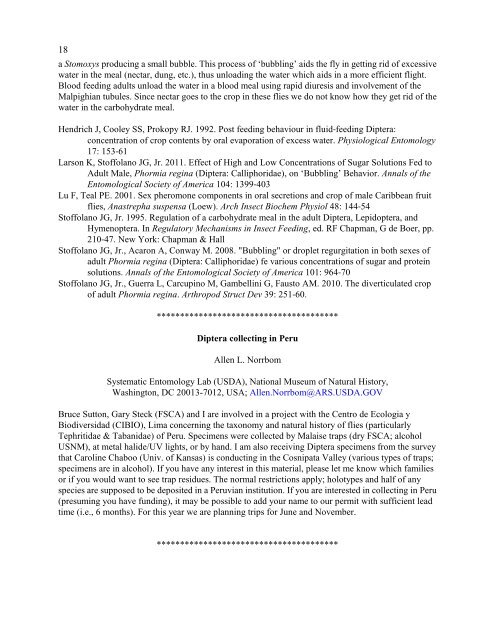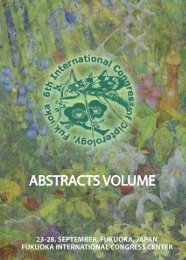Fly Times Issue 48, April 2012 - North American Dipterists Society
Fly Times Issue 48, April 2012 - North American Dipterists Society
Fly Times Issue 48, April 2012 - North American Dipterists Society
You also want an ePaper? Increase the reach of your titles
YUMPU automatically turns print PDFs into web optimized ePapers that Google loves.
18<br />
a Stomoxys producing a small bubble. This process of ‘bubbling’ aids the fly in getting rid of excessive<br />
water in the meal (nectar, dung, etc.), thus unloading the water which aids in a more efficient flight.<br />
Blood feeding adults unload the water in a blood meal using rapid diuresis and involvement of the<br />
Malpighian tubules. Since nectar goes to the crop in these flies we do not know how they get rid of the<br />
water in the carbohydrate meal.<br />
Hendrich J, Cooley SS, Prokopy RJ. 1992. Post feeding behaviour in fluid-feeding Diptera:<br />
concentration of crop contents by oral evaporation of excess water. Physiological Entomology<br />
17: 153-61<br />
Larson K, Stoffolano JG, Jr. 2011. Effect of High and Low Concentrations of Sugar Solutions Fed to<br />
Adult Male, Phormia regina (Diptera: Calliphoridae), on ‘Bubbling’ Behavior. Annals of the<br />
Entomological <strong>Society</strong> of America 104: 1399-403<br />
Lu F, Teal PE. 2001. Sex pheromone components in oral secretions and crop of male Caribbean fruit<br />
flies, Anastrepha suspensa (Loew). Arch Insect Biochem Physiol <strong>48</strong>: 144-54<br />
Stoffolano JG, Jr. 1995. Regulation of a carbohydrate meal in the adult Diptera, Lepidoptera, and<br />
Hymenoptera. In Regulatory Mechanisms in Insect Feeding, ed. RF Chapman, G de Boer, pp.<br />
210-47. New York: Chapman & Hall<br />
Stoffolano JG, Jr., Acaron A, Conway M. 2008. "Bubbling" or droplet regurgitation in both sexes of<br />
adult Phormia regina (Diptera: Calliphoridae) fe various concentrations of sugar and protein<br />
solutions. Annals of the Entomological <strong>Society</strong> of America 101: 964-70<br />
Stoffolano JG, Jr., Guerra L, Carcupino M, Gambellini G, Fausto AM. 2010. The diverticulated crop<br />
of adult Phormia regina. Arthropod Struct Dev 39: 251-60.<br />
***************************************<br />
Diptera collecting in Peru<br />
Allen L. Norrbom<br />
Systematic Entomology Lab (USDA), National Museum of Natural History,<br />
Washington, DC 20013-7012, USA; Allen.Norrbom@ARS.USDA.GOV<br />
Bruce Sutton, Gary Steck (FSCA) and I are involved in a project with the Centro de Ecologia y<br />
Biodiversidad (CIBIO), Lima concerning the taxonomy and natural history of flies (particularly<br />
Tephritidae & Tabanidae) of Peru. Specimens were collected by Malaise traps (dry FSCA; alcohol<br />
USNM), at metal halide/UV lights, or by hand. I am also receiving Diptera specimens from the survey<br />
that Caroline Chaboo (Univ. of Kansas) is conducting in the Cosnipata Valley (various types of traps;<br />
specimens are in alcohol). If you have any interest in this material, please let me know which families<br />
or if you would want to see trap residues. The normal restrictions apply; holotypes and half of any<br />
species are supposed to be deposited in a Peruvian institution. If you are interested in collecting in Peru<br />
(presuming you have funding), it may be possible to add your name to our permit with sufficient lead<br />
time (i.e., 6 months). For this year we are planning trips for June and November.<br />
***************************************
















